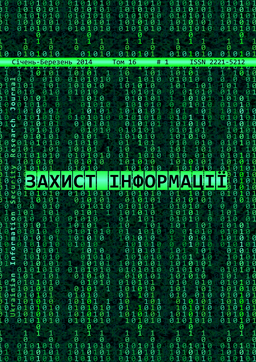The formation method of linguistic standards created for the intrusion detection systems
DOI:
https://doi.org/10.18372/2410-7840.16.6262Keywords:
cyber attacks, anomalies, fuzzy standards, the formation method of linguistic standards, intrusion detection systems, anomaly detection systems, attack detection systems, anomaly detection in computer networksAbstract
One of the information security solutions are the intrusion detection systems based on the principle of anomaly. To develop such a kind of systems the anomaly detection method generated by cyberattacks in information systems is used. In this method, the process of formation of various standards is quite complicated and practically is not formalized, that reduces the efficiency of its use. In order to compensate for this drawback it is proposed the method which is based on mathematical models and methods of fuzzy logic and is implemented through the six basic stages: formation of subsets of linguistic assessments identifiers, formation of the basic matrix of frequencies, formation of a derivative matrix of frequencies, the formation of fuzzy terms, formation of fuzzy numbers, the visualization of linguistic standards. The method enables to improve the process of formalization of linguistic standards to increase the efficiency of the corresponding detection intrusion systems.References
Корченко А.А. Система выявления аномального состояния в компьютерных сетях / А.А. Корченко // Безпека інформації. — 2012. — № 2 (18). - С. 80-84.
Корченко А.А. Система формирования нечетких эталонов сетевых параметров / А.А. Корченко / / Захист інформації. — 2013. — Т.15, №3. — С. 240-246.
Корченко А.А. Система формирования эвристических правил для оценивания сетевой активности / А.А. Корченко // Захист інформації. — 2013. - №4. Т.15. - С. 353-359.
Стасюк А.И. Метод выявления аномалий порожденных кибератаками в компьютерных сетях / А.И. Стасюк, А.А. Корченко // Захист інформа¬ції. - 2012. - №4 (57). - С. 129-134.
Корченко А.Г. Построение систем защиты информации на нечетких множествах [Текст] : Теория и практические решения / А.Г. Корченко. - К. : МК-Пресс, 2006. - 320 с.
Стасюк А.И. Базовая модель параметров для построения систем выявления атак / А.И. Стасюк, А.А. Корченко // Захист інформації. - 2012. - № 2 (55). - С. 47-51.
Korchenko А.А. Anomaly-based detection system in computer networks, Bezpeka mformaci'i, 2012, №2 (18), pp. 80-84.
Korchenko A.А. The system development of fuzzy standards of network parameters, Zahist informadi, Т.15, №3, 2013, pp. 240-246.
Korchenko A.A. The system of heuristic rules formation for network activity assessment, Zahist informacii, Т.15, №4, 2013, pp. 353-359.
Stasiuk A.I., Korchenko A.A. A method of abnormality detection caused by cyber attacks in computer networks, Zahist informadi, 2012, №4 (57), pp. 129-134.
Korchenko A.G. The development of information protection systems based on the fuzzy sets, The the¬ory and practical solutions, Kuev, 2006, 320 p.
Stasiuk A.I., Korchenko A.A. The basic model of parameters in attack detection (Identification) systems construction, Zahist informacii, 2012, №2 (55), pp. 47-51.
Issue
Section
License
Authors who publish with this journal agree to the following terms:- Authors retain copyright and grant the journal right of first publication with the work simultaneously licensed under a Creative Commons Attribution License that allows others to share the work with an acknowledgement of the work's authorship and initial publication in this journal.
- Authors are able to enter into separate, additional contractual arrangements for the non-exclusive distribution of the journal's published version of the work (e.g., post it to an institutional repository or publish it in a book), with an acknowledgement of its initial publication in this journal.
- Authors are permitted and encouraged to post their work online (e.g., in institutional repositories or on their website) prior to and during the submission process, as it can lead to productive exchanges, as well as earlier and greater citation of published work (See The Effect of Open Access).

